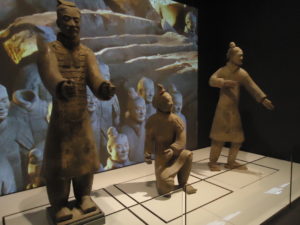My aunt booked our tickets to see the “Terracotta Warriors”:http://www.liverpoolmuseums.org.uk/wml/exhibitions/terracotta-warriors/index.aspx at World Museum in Liverpool weeks ahead of time so we would be able to see the exhibit on a recent trip to the UK. I had seen an exhibit a number of years ago at the Royal Ontario Museum in Toronto but it seemed to focus more on the battles for territory in ancient China in addition to the warriors that had been discovered. This recent exhibit though focuses more on the daily life of people during the different dynasties depicted as displayed by the artifacts buried with the emperor. We definitely noticed similarities to Egyptian tombs with people buried alive to keep them secret, sacrifices buried with the emperors and death traps for people who enter uninvited. Having just seen an exhibit on “Vikings”:https://www.silvertraveladvisor.com/review?id=190077 in Southport, we also saw a parallel with rulers seeking divine assertion of power thru gods/God.
We started our visit with a stop at the Walker Art Gallery down the street for a quick snack before our allotted visit time. My uncle was quite taken with the Victorian Gallery upstairs so we planned a return trip to check them out after we were finished at the World Museum. It’s my favourite gallery at the Walker so I didn’t need any convincing.
Now, going back 2,500 years to the Eastern Zhou Dynasty, the exhibit at the World Museum includes the history before the First Emperor’s Qin Dynasty and the Han Dynasty after the First Emperor’s reign. It was interesting to learn about the different Chinese philosophies (Legalism, Confucianism and Daoism) and the importance of the horse in Chinese society over the past 6,000 years. They were symbols of wealth and were often buried with their owners as were other inanimate objects they would continue to need in the afterlife. There is no wonder the First Emperor’s burial site is so extensive if he was expected to live in death as he did in life. I was surprised to discover that all the artifacts that have been unearthed thus far are from the burial site and not the actual tomb of the First Emperor; it has yet to be disturbed as the archaeologists have not determined a non-invasive method of exploring it. At the conclusion of the exhibit it was neat to see the surmised view of the First Emperor’s tomb. My one aunt was finished looking around the exhibit before the rest of us so she saw this show a few times. At least there were seats so she could make herself comfortable while she waited for us to join her.
The exhibit is on until October 28, 2018 and is well worth the visit.










